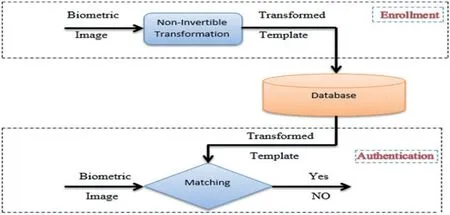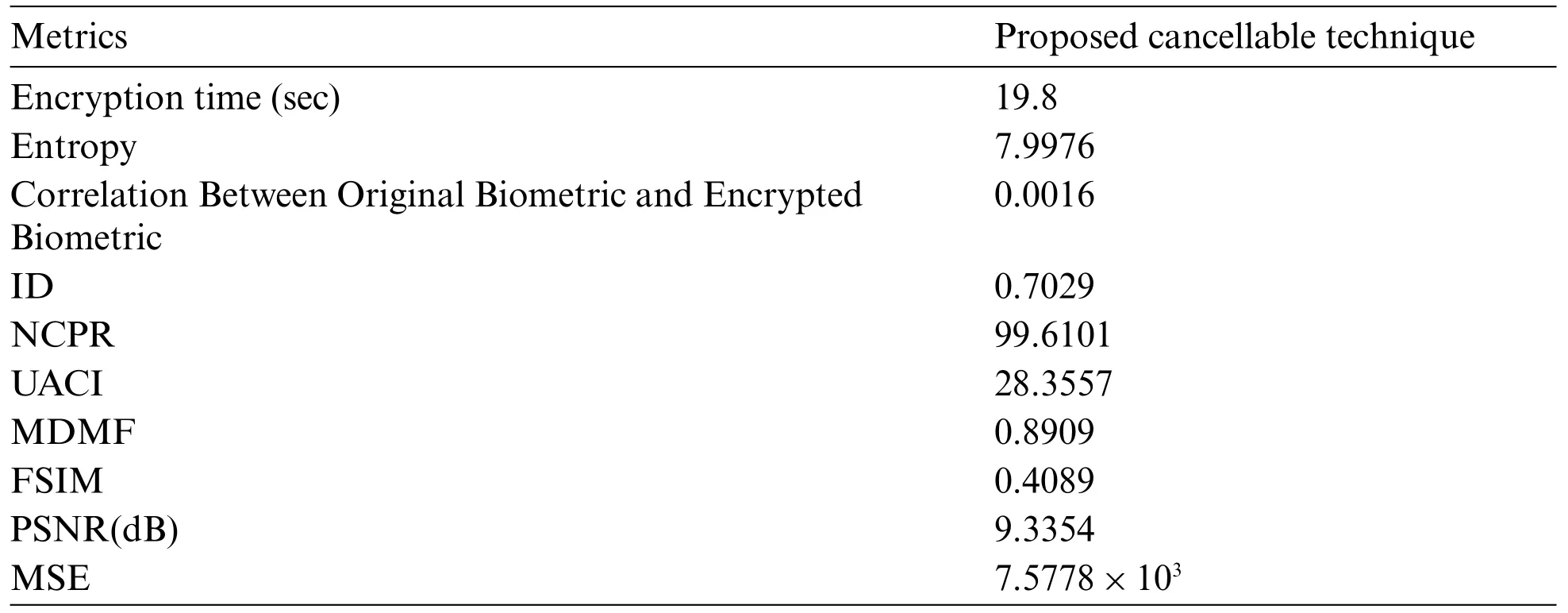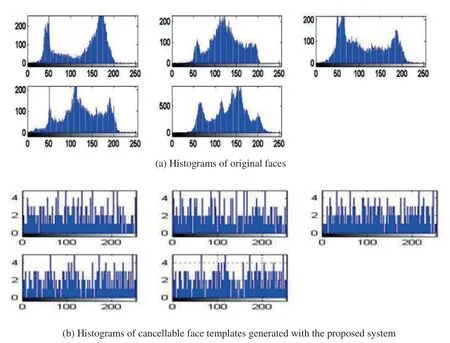Cancellable Multi-Biometric Template Generation Based on Arnold Cat Map and Aliasing
Ahmed M.Ayoup,Ashraf A.M.Khalaf,Walid El-Shafai,Fathi E.Abd El-Samie,Fahad Alraddady and Salwa M.Serag Eldin,5
1Electrical Communications Engineering Department,Faculty of Engineering,Minia University,Minia,61111,Egypt
2Electronics and Electrical Communications Engineering Department,Faculty of Electronic Engineering,Menoufia University,32952,Menouf,Egypt
3Security Engineering Lab,Computer Science Department,Prince Sultan University,Riyadh,11586,Saudi Arabia
4Department of Computer Engineering,College of Computers and Information Technology,Taif University,P.O.Box 11099,Taif,21944,Saudi Arabia
5Department of Electronics and Electrical Communications Engineering,Faculty of Engineering,Tanta University,Tanta,Egypt
Abstract: The cancellable biometric transformations are designed to be computationally difficult to obtain the original biometric data.This paper presents a cancellable multi-biometric identification scheme that includes four stages:biometric data collection and processing,Arnold’s Cat Map encryption,decimation process to reduce the size,and final merging of the four biometrics in a single generated template.First,a 2D matrix of size 128×128 is created based on Arnold’s Cat Map(ACM).The purpose of this rearrangement is to break the correlation between pixels to hide the biometric patterns and merge these patterns together for more security.The decimation is performed to keep the dimensions of the overall cancellable template similar to those of a single template to avoid data redundancy.Moreover,some sort of aliasing occurs due to decimation,contributing to the intended distortion of biometric templates.The hybrid structure that comprises encryption,decimation,and merging generates encrypted and distorted cancellable templates.The simulation results obtained for performance evaluation show that the system is safe,reliable,and feasible as it achieves high security in the presence of noise.
Keywords: Aliasing technique;selective encryption;ACM;decimation process
1 Introduction
Compared with traditional authentication systems,biometric authentication systems have certain advantages over systems that adopt passwords and Personal Identification Number (PIN) codes.In biometric systems,authorized users only should have the ability to access personal information.Hence,information security needs to be guaranteed.These systems require authenticated persons to provide their unique personal data during the authentication period[1].Therefore,a biometric authentication system is a reliable and safe choice.Biometric identification is a method of identifying people based on their certain personal characteristics[2].Physiological biometric technology uses a person’s unique physical characteristics,such as fingerprints,faces,palm prints,iris,or Deoxyribonucleic Acid(DNA)sequences,to identify users,and it has proven to be a powerful tool in identity verification systems.The main advantage of biometrics is that they are not vulnerable to theft and loss.They are independent of users’memory.Moreover,they do not change significantly over time,and it is difficult for a person to change his own physiological biometrics or imitate someone else measurements.Among the various biometrics in security applications with the scope of the digital collection,palm prints have recently received more attention among researchers[3].
The popularity of biometrics is driven by two factors:technological progress and safety requirements.For a long time,the need to use special sensors to collect biometric data has been considered a disadvantage,especially when viewing multiple biometric data.There should be an ability to collect data using modern sensors.For example,smartphones contain several potential biosensors,some of which are designed to be used,such as fingerprint scanners,while others can capture biometric data as auxiliary tools,such as digital cameras.High-resolution images are used for face recognition,iris recognition,and retina scanning.Microphones are used for recording.In addition,walking needs an inertial sensor.Of course,the same computer can be used to collect personal data,which requires further research on the security of the system[3].
The biometric devices may be defective,and errors may occur.There are two types of error measurement metrics in biometric systems:False Rejection Rate (FRR) and False Acceptance Rate(FAR).If the device rejects an authorized person,this counts into the FRR,and if the device accepts an unauthorized person,this counts into the FAR.By combining two or more physical characteristics to determine the FAR and the FRR,a multi-biometric system has been built with other levels of precautions[4].
Biometric systems are usually prone to problems such as sensor data corruption,missing characters,under-representation,overshoot,and incompleteness.The multi-modal biometric identification system can reduce the Failure-To-Capture(FTC)and Failure-To-Enroll(FTE)values and provide the highest level of anti-counter-feting protection,because it is difficult to develop multiple biometric sources at the same time.In the feature extraction process,fingerprint and iris feature extraction can be implemented with multi-modal biometric systems.We improve the realization of multi-modal biometric characteristics.
This article is divided into five parts.The first part introduces the cancellable biometric concepts,biometric security and privacy issues,and the main contributions of the proposed cancellable biometric algorithm.The second part introduces the related work of various researchers in this field.In the third part,we introduce the proposed algorithm and the authentication strategy.In the fourth part,we introduce the simulation results.Finally,we give the conclusion and future work.
1.1 Cancellable Biometric Concepts
The cancellable biometric transformation is designed to be computationally difficult to obtain the original biometric data.As shown in Fig.1,the original image is not used,but an irreversible image transformation is used,alternatively.In case the cancellable template is stolen,it can be overwritten through another transformation.This can protect user privacy,because it is computationally difficult to restore the original patterns from the transformed templates.In addition,the templates can be changed easily in hacking scenarios.This methodology prevents database overlap,because each application has a different conversion (See Fig.2).In addition,this methodology does not affect the accuracy of the matching process,because the statistical properties of the attributes are roughly preserved after conversion[5-7].

Figure 1:Layout of a cancellable biometric authentication system[5-7]
1.2 Security and Privacy Aspects of Biometric Systems
Biometric systems are considered as secure tools of identity verification,but fraudsters have also developed new methods to bypass the security of biometric systems.The problem with biometric authentication systems is that the biometric data is not confidential.There are eight possible attacks on biometric systems[8].Fig.2 shows various attacks at different points in the biometric verification system.

Figure 2:Various attacks at different points of the biometric system[9]
Attackers can display fake biometric data in front of the sensor [9].For example,a person can create a fake finger with a fake fingerprint at the sensor.We can bypass the facial recognition system and take a photo of a legitimate user in front of the camera.In addition,we can use some lenses to avoid scanning of the iris [8].Fig.1 shows the possible attacks and possible solutions for biometric systems.
1.3 Contributions and Novelty
The main contributions of this paper are summarized as follows:
1) Proposal of a cancellable multi-biometric encryption technique that achieves a decrease in the over-execution enrollment process compared with the cancellable biometric technique in[10].This proposal has a total runtime of 19.8 s,which makes it more suitable for real-time and Internet-of-things(IoT)applications.
2) Introducing a new cancellable biometric recognition technique using a combination of decimation and aliasing with the help of chaotic Arnold’s Cat Map(ACM).
3) Performance evaluation of the proposed cancellable biometric system with metrics including entropy,correlation,etc.The proposed system is more favorable compared to traditional ones.
4) The proposed cancellable biometric system reveals high immunity to noise effect.
2 Related Work
Several attempts have been presented in this field by several researchers for cancellable biometrics[11].Ross et al.[12]provided an overview of optical image coding.The numerical simulation of this method for cancellable biometrics shows its robustness and the high sensitivity to the correct switching offset.The presented results quantify the robustness of this method based on Mean Square Error(MSE)values with the same number of key changes.We can say that for the same key value,a higher MSE can indicate a higher resistance to noise and attacks.
Ross et al.[13]presented a cancellable multi-modal biometric system.The widespread use of Double Random Phase Encoding (DRPE) allows to create a fragile multi-biometric identification system.The purpose of the system is to provide storage space for the biometric database,and improve security.Kamaldeep et al.[14]proposed a reversible multi-index iris recognition method based on several important parameters in a mixed mode.The feature vectors generated by the left and right iris of the same subject are merged into the safety symbol.The DRPE method is used in the Fractional Fourier Transform(FrFT)domain to generate irreversibly encrypted codes.The cancellable biometric system avoids sending the keys and improves the confidentiality of authentication,because each user has a unique key to receive the encrypted iris code.Experimental results show that the use of this iris recognition method improves privacy,while maintaining authentication performance,achieving a 0.63%energy efficiency and a 99%accuracy.It was concluded that the DRPE is a valid candidate to obtain revocable biometric templates.
Jain et al.[15]proposed an effective method for identifying revocable fingerprints based on the identification process used to verify fingerprints without restoring the original fingerprints.This helps to protect fingerprints from attacks,because the authors used an irreversible transformation.Liu et al.[16]presented a multimedia biometric system based on a combination of fingerprints and faces.The Gabor transform is applied on the image in the mixed pixel layer.This scheme is very effective for small sample scenarios.Zakaria et al.[17]presented a new strategy using the nested sequence array method.The Discrete Cosine Transform(DCT)is used to extract facial features and hand-prints,but serialized into a nested array.The parameters of the feature sequence and its statistical distribution can be estimated.The main advantage of this method is that it supports large databases compared to classic methods.The authors compared their method with other methods,and showed that the detection accuracy of their proposed method is 99.7%,which is higher than those of other methods.
Soliman et al.[18]have worked on four different categories:left and right palms,crossed left palms,left palms with fingerprint samples,and right palms with fingerprints.Left and right fingerprints of the same subject can be used to create matching scores to improve the matching accuracy.Both left and right palm print scores can be compared for better recognition.Ahmad et al.[19]proposed a multi-model system of the left thumb and left ear.The main feature of this system is to improve the stage of thumb imaging before feature extraction.The authors applied Gaussian smoothing of the thumb image.To optimize the performance,Zhang Suen(ZS)dilution algorithm turned out to be a good algorithm.Hearing aids use 5 of 9 functions.The system can operate at a reliability level/range of 80%.It can be increased to100%by adding 4 additional ear functions.Taher and Mosseb et al.[20]proposed a cancellable iris recognition scheme based on the combination of encoding and irreversible transformations to conceal the characteristics of the iris.Its recognition rate reaches 99.9%.
3 Proposed Cancellable Biometric Recognition Framework
The proposed approach begins with four biometric acquisition.After that,Arnold’s Cat Map(ACM) encryption is applied on all biometrics.Decimation by 2 is adopted on encrypted templates to generate four decimated and encrypted versions of all biometrics.These four versions are merged together to a single 3D matrix.Some sorts of decimation in rows and decimation in columns are applied to get two templates that have both encryption and aliasing effects.Finally,a sophisticated merging operation is implemented on these two versions to get a final 256×256 cancellable biometric template that can be used for biometric verification(See Fig.3).
Step 1:Acquisition of Biometric Images
Input biometric data is collected by various sensors.For example,human face images are taken by cameras and video cameras;fingerprints and hand geometry are recorded by sensors;iris and retina are scanned by infrared cameras.In this article,all face biometric data of individuals used in the proposed cancellable biometric system are extracted from the faces database[21].
Step 2:Arnold’s Cat Map
Arnold’s Cat Map (ACM) is a confusion map named after Vladimir Arnold.ACM [22-24]can be used to encode images to increase security.The image(not necessarily a cat)is treated by random changes in the original pixel arrangement.However,the map has a constant period.ACM has two main disadvantages.It is sometimes possible to restore the original image.In addition,the histogram of the encoded image is the same as that of the original image,because the values of the pixels are not changed[24].
Step 3:Decimation Process
In the decimation or down-sampling process,the image dimensions are reduced to one-half or onethird of the original ones.The decimation process eliminates redundant pixels that are not necessary for the generation of cancellable templates(See Fig.4).

Figure 3:(Continued)

Figure 3:The layout of the proposed cancellable template generation

Figure 4:Down-Sampling process from the N×N image to an(N/2)×(N/2)image[25-28]
The decimation model can be represented as follows[25-28]:

where f,g are lexicographicly ordered versions of the original encrypted image and the decimated version,respectively.D is the decimation operator given as follows:

where ⊗is the Kronecker product,D1represents a filtering operation.

Step 4:Merging Process
The four obtained biometric templates ACM encryption,and decimation processes are merged together,as illustrated in Fig.3.The four biometrics are arranged in a single 2D matrix through the selection of certain rows and discarding others.A row is taken,and three other rows are discarded.This process is also repeated for columns.Hence,the final obtained matrix has dimensions of 256×256.The discarding strategy does not affect the cancellable biometric template generation as few pixels can represent each template differently if derived based on the original biometric template[29-32].
4 Authentication Strategy
The authentication strategy of the proposed system is shown in Fig.5.A correlation-based strategy necessitates the generation of cancellable templates in the testing process in the same manner used for training.Correlation is estimated,and the decision is made based on a threshold value for verification.

Figure 5:Block diagram of the proposed system revealing the authentication strategy
5 Simulation Experiments and Results
The proposed system is applicable to biometric images of different sizes.Performance assessment is implemented based on Equal Error Rate(EER)and Receiver Operating Characteristic(ROC)curve in addition to some cryptographic test criteria.Simulation experiments shown in Tabs.1 to 7 have been carried out on MATLAB 2014a,Core(TM)i74600U,CPU 2.10 GHz,8GB Windows 7 on an Intel(R)laptop.The girl image is used to allow the imposter test.

Table 1:Output of different stages of the proposed cancellable biometric recognition system in Fig.7a
5.1 Quality Assessment
There are several metrics that are widely used to evaluate the image quality,such as MSE,entropy,Peak Signal-to-Noise Ratio (PSNR),correlation,differential maximum deviation,and Feature Similarity Index Method(FSIM).Statistical tests are applied to evaluate the performance of the encryption process.Tab.3 shows the measurement of the Proposed cancellable biometric technique for an unauthorized face.
Tabs.4-7 shows the measurement of the proposed cancellable biometric technique for an authorized face.

Table 2:Output of different stages of the proposed cancellable biometric recognition system in Fig.6

Table 3:Metrics for the proposed cancellable biometric recognition technique for 256×256 girl.jpg unauthorized data IN Fig.6

Table 3:Continued

Table 4:Measured metrics for the proposed cancellable biometric recognition system for 128×128 authorized data in Fig.7a

Table 5:Measured metrics for the proposed cancellable biometric recognition system for 128×128 authorized data in Fig.7c

Table 6:Measured metrics for the proposed cancellable biometric recognition system for 128×128 authorized data in Fig.7b

Table 7:Measured metrics for the proposed cancellable biometric recognition system for 128×128 authorized data in Fig.7d
5.2 Performance in the Presence of Noise
In the presence of different levels of noise and different degrees of correlation between pixels,the authorized user correlation distribution,the unauthorized user correlation distribution,and the ROC curve are analyzed.Fig.8 shows the samples of face templates created according to the proposed system.Fig.9 shows a better degree of uniformity in histograms after encryption,which ensures more security of the cancellable templates.The correlation distributions for both genuine and imposter tests are illustrated in Fig.10.In addition,the ROC curve is illustrated in Fig.11.Tab.8 illustrates the evaluation metric values of the proposed system in the presence of different levels of noise.It is clear from this table that the performance of the system deteriorates with the increment of the noise level,but the system still works,and it is still able to discriminatebetween users.

Figure 6:The 256×256 girl image

Figure 7:The 128×128 original imposter and genuine templates[21]

Figure 8:Samples of face templates created according to the proposed system.(a) Original face,(b)Encrypted face template output

Figure 9:(a) Original faces and (b) Histograms of the cancellable face templates created with the proposed system

Figure 10:Genuine and impostor distributions

Figure 11:ROC curve

Table 8:Performance metrics of the proposed cancellable biometric recognition system in the presence of noise
6 Conclusions and Future Work
This paper examined the benefits and challenges of using biometrics as a means of identity verification and presented a multi-biometric encryption scheme as a solution to the different security and privacy issues faced by users of biometric authentication systems.The proposed scheme combines a variety of biometrics with the help of Arnold’s Cat Map (ACM),a decimation process to induce aliasing,and a merging process to create cancellable templates.The obtained templates ensure randomness due to the utilization of the ACM fusion and aliasing strategies.The proposed system aims to reduce the time of the registration process and increase the reliability of the template change process.By calculating the EER and the AROC,the superiority of the proposed system is demonstrated.A comparative study of the proposed system with other ones has been presented.The simulation results obtained for performance evaluation show that the system is safe,reliable,and feasible as it achieves high AROC values in the presence of noise.Future work may include the development of new algorithms for security in healthcare applications.We will also take into consideration the investigation of the effect of complex channel degradations on the proposed system.
Acknowledgement:The authors thank the researchers of Taif University for their support.They support project number(TURSP-2020/214),Taif University,Taif,Saudi Arabia.
Funding Statement:This research was supported by Taif University Researchers Supporting Project Number(TURSP-2020/214),Taif University,Taif,Saudi Arabia(www.tu.edu.sa).
Conflicts of Interest:The authors declare that they have no conflicts of interest to report regarding the present study.
 Computers Materials&Continua2022年8期
Computers Materials&Continua2022年8期
- Computers Materials&Continua的其它文章
- Deep Learning Framework for Precipitation Prediction Using Cloud Images
- Fuzzy Logic with Archimedes Optimization Based Biomedical Data Classification Model
- Competitive Swarm Optimization with Encryption Based Steganography for Digital Image Security
- Underwater Terrain Image Stitching Based on Spatial Gradient Feature Block
- Spider Monkey Optimization with Statistical Analysis for Robust Rainfall Prediction
- An Integrated Framework for Cloud Service Selection Based on BOM and TOPSIS
